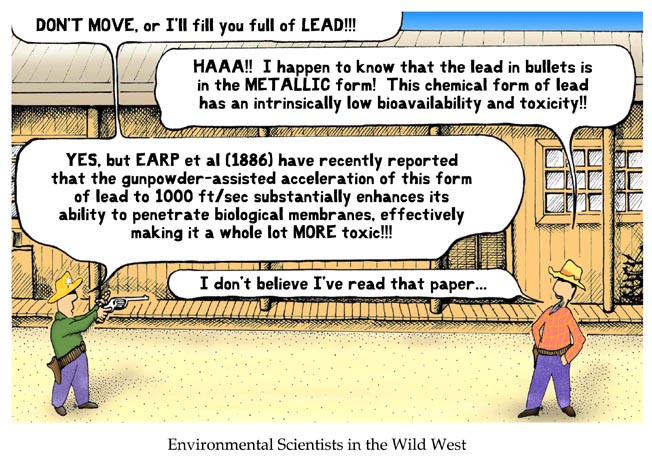In the Wild West someone said to have “lead poisoning” usually died of a gunshot wound, although some actually probably did die of illness caused from excessive exposure to lead. (Annie Oakley, so they say). While it would be extraordinary today for a frequent shooter or instructor to die of illness caused by long term exposure to the heavy metals associated with ammunition, the serious inhalation and contact hazards associated with shooting, handling ammunition components, and cleaning of firearms can and should nevertheless be minimized. This is especially critical if you or someone in the household is pregnant or have children in your home.
If you shoot indoors or spend time on an indoor range (or shoot house) while others shoot, your blood lead level should be tested at least twice a year. (Everyone else reading this, once per year is probably sufficient). The level of lead in the blood is measured in micrograms per deciliter. Theoretically, there should be no lead in the human body, but there are several ways we are exposed to it in our lifetime. Thus, few have a near 0 blood lead level. Blood lead level figures reflect cumulative exposure; it takes several months, possibly up to one year, for the level to recede. If you stop shooting indoors entirely, your blood level should show a dramatic drop in about six months.
Here are the conservative levels I apply in monitoring myself. If my blood lead level is consistently below 15, I do not have concerns, absent symptoms. If it is frequently more than 15 but less than 25, I limit time in the indoor range, whether shooting or instructing, and consider wearing a special particulate-rated respirator mask. If the level is more than 30, I promptly stop all indoor range activities and have a physician run further tests for deficiencies and conditions normally associated with lead poisoning. (Reproductive health may be affected at level of 30 and above). Another commonly available blood test is the ZPP (zinc protoporphyrin), used to determine chronic exposure over longer intervals. A doctor may want to run that test as part of a regular diagnostic routine once a higher than the upper limit normal (about 25) level has been detected more than once. Adults are rarely given treatment for lead poisoning by medical intervention (usually IV chelation), since the treatment itself carries risks.
Lead contamination by inhalation, ingestion, and skin exposure can be minimized if you shoot in well ventilated, regularly cleaned ranges. You can reduce exposure if you shoot early in the day, before the range air becomes saturated, leave the range area when not shooting or actually instructing, and by using fully encapsulated or nontoxic loads. When you handle used brass or clean firearms, wear disposable (I use powder-free nitrile) or washable, reusable solvent proof gloves with long cuffs. Throw out cleaning patches and cloths outdoors and promptly. Keep your hands away from mouth, eyes, and nose. Always keep open wounds on the hands and arms covered. If you use toxic cleaning products indoors, open several windows and wear a light respirator mask.
I have certain protocols for decontamination after shooting or instructing, on any range. I recommend and regularly use products by Esca-Tech, the manufacturer of D-Lead® products. They contain complex compounds which decontaminate skin of heavy metals. The product line includes skin wipes, smooth/abrasive and waterless hand soaps, body and hair shampoo, laundry detergent, and surface wipes. Protocols I follow have kept my blood lead level at under 16, and rapidly reduced a twice elevated level (20-25), in about three months, even while still shooting once or twice weekly indoors, several times per month outdoors, and cleaning several handguns weekly. .
Here are some of the decontamination protocols I follow: Never bring food into or eat in or near an indoor range, or eat without first decontaminating hands and face. Wash your face, hands, and arms with decontamination soap and cold water (warm opens pores), and wipe your hair (including facial if any) with a regular baby or D-Lead® wipe before you leave the range. Blow your nose and clean your nostrils with a wipe. Flush with nasal saline if necessary. Before you drive away from the range, wipe down your range bag and other exposed gear (cell phone, eye and ear protection). Avoid bringing fabric range bags into the range, as over time these become impregnated with the range smell and airborne particulates.
When you return from the range, rinse your dedicated range shoes outdoors, wipe down your vehicle seat and rinse the floor mat. Bag and leave your range clothing and shoes in the garage or utility room, away from the kitchen and its sink. Wash range clothing separately from regular laundry and give them an extra rinse. Keep clean range clothing apart from your regular attire. Shower and shampoo as soon as possible, first with soap and cold water. For washing of hands, use bathroom sink, not kitchen. Use abrasive hand soap, or a nail brush to scrub your fingers and under your nails. (The D-Lead® product line mentioned above includes several type hand and body soaps and shampoo).
In addition to decontamination protocols, I have used supplements and homeopathic self-help to help keep my blood lead level in check, including making sure my intake of calcium, iron, and zinc were high, and by reducing high dose Vitamin D supplementation when my blood lead level was over 20. I have also used homeopathic remedies available at health stores with apparent positive result of lowering the blood lead level. These include non-FDA approved oral chelation agents (algin, EDTA, antioxidants, and others) found in heavy metal detox and cardiovascular formulations.
Healthy Hunting, Stay 10-8.



